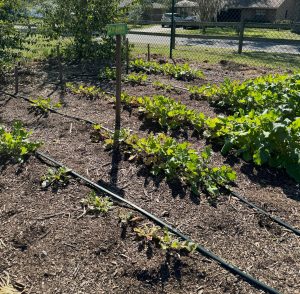What is Drip Irrigation?
Instead of showering plants with water from above like sprinklers, micro-irrigation delivers water to the base of the plant. This type of irrigation consists of drip, micro-sprinklers, and bubblers. Drip lines are a network of tubes that release water gently at the base of each plant. Micro-sprinklers wet a larger area compared to true drip irrigation.

The Benefits of Micro-Irrigation
Cool, right? The good news is micro-irrigation is a more efficient form of irrigation than sprinklers. Since the water is released at the base of the plant near the roots, there’s less waste from evaporation, wind scatter, and runoff. You won’t have to worry about wasted water. Compared to sprinklers, micro-irrigation systems use a lot less water, at a slower rate. Plus, it is better for your plants’ health. When set up properly, the system can be set up to release the right amount of water, so your garden is not drowning or thirsty. This method also helps to prevent pests and diseases because water is not landing on the foliage from overhead.
These systems are easy to install and will require maintenance to function properly. There are also several ways to install these systems. Depending on the type you choose, you can place them on the surface of your garden, just under a layer of mulch, or bury them in the soil. This is advantagous to the appeal and aesthetic of the garden, because there arent any visibly gadgets, hoses, or sprinkler heads. They work for in-ground and container-grown veggies alike.
This method might take a little work upfront, but it will save you time and money in the long run while keeping your plants happy and healthy.
The Disadvantages of Drip Irrigation
Again, these systems require more maintenance than sprinklers. While it is a more accurate and efficient way of watering plants, plant placement will have to correspond to the spacing of the the emitters (where the water is released) to receive water. Depending on where you decide to place your hose, it may be hard to detect a leak, especially if it is under the soil or a layer of mulch. Since these systems deliver water at a slower rate, it is required that a lower pressure is supplied by using an appropriate pressure regulator.
This is why maintenance of your system is important!
It is the Law
In many parts of Florida, irrigation frequency (e.g., time of day, day of week, etc.) is regulated by water management districts. Know the regulations in your area and comply with the law.
A lesser known fact is that automatic irrigation systems must have a functioning rain sensor or other device to bypass irrigation if sufficient water has been supplied by rainfall. You likely have one of these on the roof of your home. Licensed contractors are required by law to install, repair, or replace these control devices if they are not installed and working properly before doing any other work on an irrigation system (Section 373.62, Florida Statutes). Read more here.
A Tip for the Floridian Gardner
What soil type do you have? Are your plants in-ground or in containers? Sandier soils, like the ones in Florida, drain a lot faster, and could require more frequent waterings to keep plants happy – depending on their watering requirements. This is also true for container plants. Even with rich soil with good texture, soil in containers may dry out faster. Keep an eye on your soil moisture, and only water when you find your plants need it! Always keep an eye out for water mandates from the Water Management District, click here for more information.

Conclusion
By being mindful of how we use water in our gardens and on our lawns, we can help conserve this precious resource while keeping our plants happy and healthy. Overall, promoting conservation, efficiency, and responsible practices ensures clean water availability, protecting Florida’s environment and supporting future generations.
For more information about water use and conservation in Florida, see Water Resources.
Read the series:
Have a question?
If you have any questions about gardening in Central Florida, please contact UF/IFAS Extension Pasco County at 352-518-0156. For more information on UF/IFAS Extension Pasco County Community Gardens, and how you can join one, visit http://sfyl.ifas.ufl.edu/pasco/. Supervising Agent: Dr. Whitney Elmore.
Follow us!
We have several ways to connect. Visit our Facebook, Instagram, Eventbrite, Blogs, Florida-Friendly Facebook, & Website.
Visit our page for more tips and tricks on maintaining a home garden!
More resources from UF IFAS Extension:
- Lawn Irrigation
- Irrigation
- Ten Ways to Save Water
- Rain Gauges and Rain Sensors
- Florida-Friendly Landscaping™ Program
UF/IFAS Publications
 4
4
